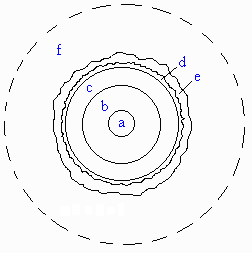
PHYSICS 1040 - ELEMENTARY ASTRONOMY - HOMEWORK #9
1. Sun data: Average distance from Earth = 1.0 A.U.
Light travel time to Earth = 8.32 minutes
Rotational period = 25 days (at equator)
35 days (at poles)
Diameter = 109 x Earth=s diameter
Average density = 1.41 x water=s density
Average temperature = 5800 K (at surface)
1.55 x 107 K (at center)
Luminosity = 3.9 x 1026 watts
Composition (by mass) = 74% hydrogen
25% helium
2. The temperature at Sun=s center is about 15.5 million Kelvin, and the density at the Sun=s center is about 160,000 kilograms per cubic meter. (Water= s density is 1000 kilograms per cubic meter.) Nuclear fusion reactions occur in the hottest, densest part of the Sun and other stars -- in the central core. The nuclei of atoms have a positive/negative (circle one) electric charge, and these electric charges repel each other. However, in the hot central part of a star, the nuclei are moving very fast, and can overcome the electrical repulsion. In the hot cores of stars, the nuclei can get close enough to fuse together.
3. The nuclear fusion reactions that take place in the Sun's core (the proton - proton chain) convert four hydrogen nuclei (protons) into a helium nucleus. For every 1000 grams of hydrogen that go into these reactions, only 993 grams of helium come out. The missing mass has been converted into energy (heat and light) according to Einstein's famous formula E = mc2. These reactions also produce "ghost particles" called neutrinos. These particles have almost no mass, and hardly interact at all with matter. They travel from the center of the Sun to the surface in just a few seconds, and then stream out into space. Every second, 450 billion of these "ghost particles" pass through each square inch of your body!

4. In the drawing at right of the interior of the Sun and its atmosphere, identify a) the central core, where nuclear fusion reactions take place; b) the radiative zone, where energy is carried outwards by photons; c) the convective zone, where energy is carried outwards by rising hot gas; d) the photosphere; e) the chromosphere; and f) the corona.
5. What holds the Sun up against the inward pull of its own gravity? As you travel deeper into the Sun from its surface, the gas pressure is constantly increasing/decreasing (circle one). There is more pressure at the bottom of any layer of gas than there is at the top of the gas layer. The extra pressure on the bottom holds the gas layer up against gravity. This balance between pressure and gravity is called hydrostatic equilibrium.
6. As you travel deeper into the Sun from its surface, the temperature is constantly increasing/decreasing (circle one). However, if you just stay at one location inside the Sun, the temperature does/does not (circle one) change with time. This is called thermal equilibrium.
7. Two processes carry energy from the center of the Sun to its surface. From the center of the Sun to 71 percent of the way to the surface, energy is carried by radiation (photons). This is called the radiative zone. In the outer 29 percent of the Sun, energy is carried by convection (hot gas rising and cool gas falling). This is called the convection zone. It takes about 170,000 years for energy generated by nuclear fusion at the Sun=s center to reach the surface. The energy released by the Sun per second, called the Sun=s luminosity, is 3.9 x 1026 watts.
8. Our Sun is constantly vibrating as sound waves ripple through its surface. The science of helioseismology studies these vibrations just like we study seismic waves caused by earthquakes on Earth. The results reveal details about the Sun= s interior structure.
9. The Sun exhibits differential rotation; it rotates faster at its equator than at its poles. This means that, as the Sun rotates, its magnetic field gets wrapped up and develops kinks in it. If one of these kinks in the magnetic field breaks through the Sun=s surface, convection (hot gas rising and carrying energy to the surface) is not as efficient. As a result a cool spot forms on the Sun=s surface. This spot doesn=t glow as brightly as the rest of the Sun=s surface, so we see a dark spot called a sunspot. The Sun=s magnetic field reverses direction every 11 years, and thus there is an 11-year sunspot cycle, with the number of spots reaching a maximum every 11 years.
10. Different layers of the Sun's atmosphere can be studied by examining different features of the solar spectrum. The body of the Sun is a sphere of hot, dense gas, so the Sun produces a continuous spectrum of light of all colors. The photosphere (the visible Asurface@ of the Sun) is a cooler, rarefied gas that is in front of the hot, dense Sun. This means that the photosphere can absorb light of certain wavelengths from the continuous spectrum of the hot, dense Sun below, thus producing dark absorption lines in the solar spectrum. The chromosphere is a rarefied gases that is hotter than the layers beneath. Therefore the chromosphere produces bright emission lines in the solar spectrum. The corona is the outermost part of the Sun's atmosphere. It is very hot, with a temperature of 1 - 2 million K. According to Wien's Law, the corona will emit x-rays.